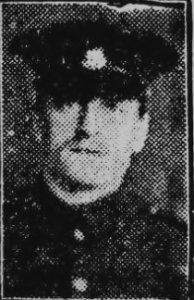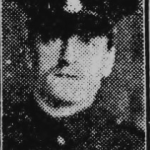
BORN HULL, 1887. SON OF CHARLES HENRY & LYDIA JEFFREY, OF 7 MARFLEET AVENUE, CRAVEN STREET, HULL (1901 CENSUS) AND 1 FLORAL GROVE, ARUNDEL STREET, HULL. EMPLOYED AT THE CORPORATION CART WORKS, WINCOLMLEE. HE ENLISTED IN THE HULL PALS. SERVED IN EGYPT AND FRANCE WITH THE 11TH EAST YORKSHIRE REGIMENT. AWARDED THE MILITARY MEDAL (MM), FOR “BRAVERY IN THE FIELD”. KILLED IN ACTION, ON 26/03/1918, AGED 31. (HDM 06/03/1918 * & 01/05/1918 .
Hull Pals Memorial Post. L/CPL GEORGE ALFRED JEFFERY 11/136. Born in January 1887, George was one of seven children to Charles and Lydia Jeffery of 1 Floral Grove, Arundel Street, Hull. A Blacksmith’s Striker by trade, he queued outside City Hall on Monday 7th September 1914, the first day of recruitment for the new Pals battalion, the 11th East Yorks, ‘The Tradesmen’. From the start it became clear that discipline and our George were not willing bedfellows. Here’s a handful of highlights from his rap sheet: “Improperly dressed in public”; “Irregular conduct in town”; “Overstaying pass”; “Absent from tattoo”; “Drunk in line of march”; “Neglect of duty”; “Irregular conduct on parade”; “Drunk on a public vehicle on Holderness Road”
and yet he must have proved himself quite a soldier, for he was not only promoted, but was awarded the Military Medal for his bravery in battle. A veteran of Egypt, the Somme and the bloodbath at Oppy Wood George was killed in action on 26th March 1918 during the early days of the German Spring Offensive as the tide of the war turned and for a few weeks it looked as if all was lost. George’s body was never recovered and his name is commemorated on the Arras Memorial; he was 31 years old.
Background. When the German spring offensive opened on 21 March 1918, 31st Division was in reserve, with 10th and 11th EYR Battalions digging trenches in the ‘Army Line’ behind the front. On 23 March the division was sent up to hold off the German attack at St Léger, but 92 Bde remained in reserve at Ervillers, improvising the defences. Ervillers was attacked on the evening of 24 March, the defence being confused by British troops retreating from the forward defences. Two companies of 10th Bn were pushed up to reinforce 11th Bn fighting in the village streets. About midnight a German patrol got into the village, but was captured by 11th Bn’s HQ staff. The following day the 11th Bn was reinforced by 10th Bn Manchester Regiment of 42nd (East Lancashire) Division and their combined fire stopped the German advance. However, events elsewhere meant that the 31st and 42nd Divisions were ordered on the morning of 27 March to retire through Courcelles-le-Comte.
On 27th March 1917, the brigade defended Ayette aerodrome against repeated attacks from 11.20am to 16.30pm, when with both flanks ‘in the air’, the brigade pulled back to the partly-dug ‘Purple Line’ in front of Ayette village. Between 24 and 27 March, 10th EYR Bn had lost 211 officers and men, and was praised “for its exceptional gallantry on March 27” by the Commander in Chief of the BEF, Sir Douglas Haig. During the night, Lt-Col Headlam of 10th Bn led up a composite battalion of troops from the quartermasters’ details of all three battalions to take over part of the Purple Line, and they helped to recover some 18-pounder ammunition from behind enemy lines, which was fired the following day. Although fighting continued elsewhere along the line, 28 March was a quieter day for 92 Bde, and 11th Bn took over some trenches started by 210th Field Company, Royal Engineers, which they continued to dig. The brigade was relieved on 31 March and marched back to billets near Pommier.

